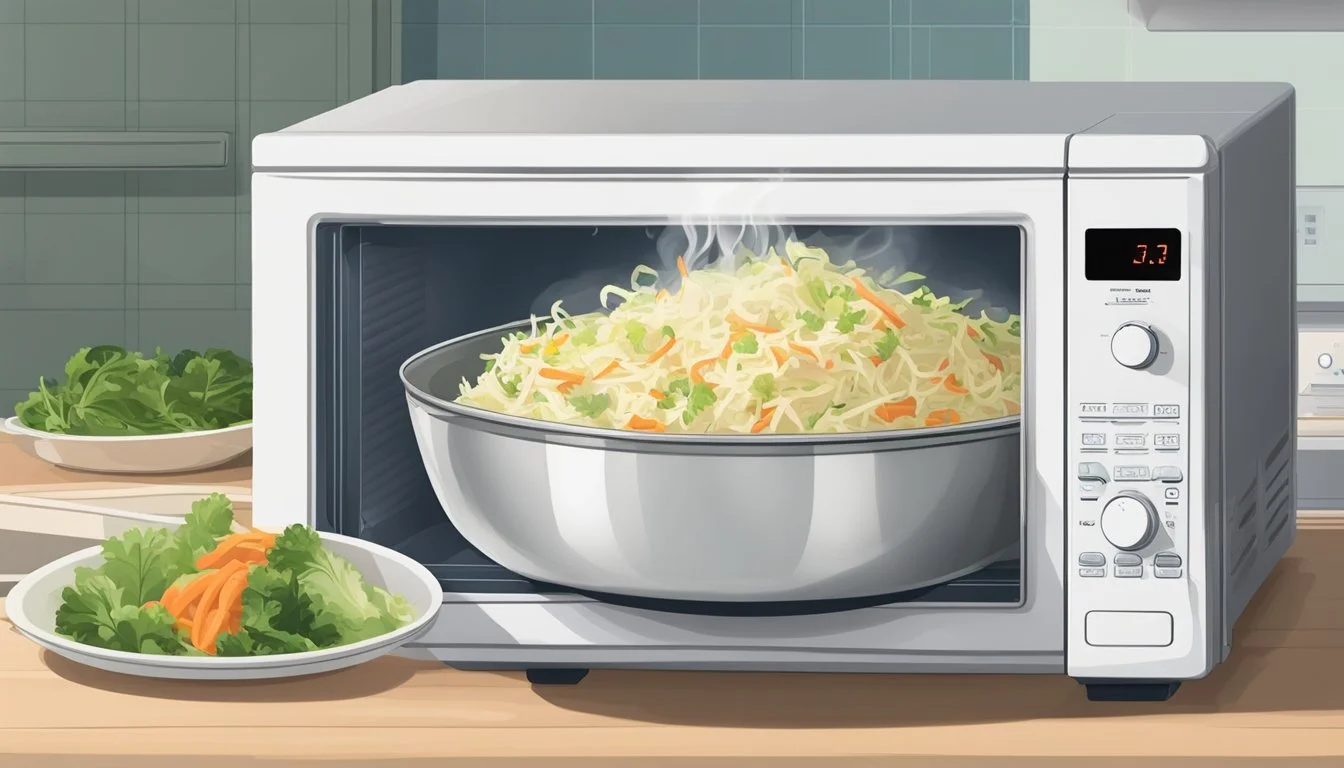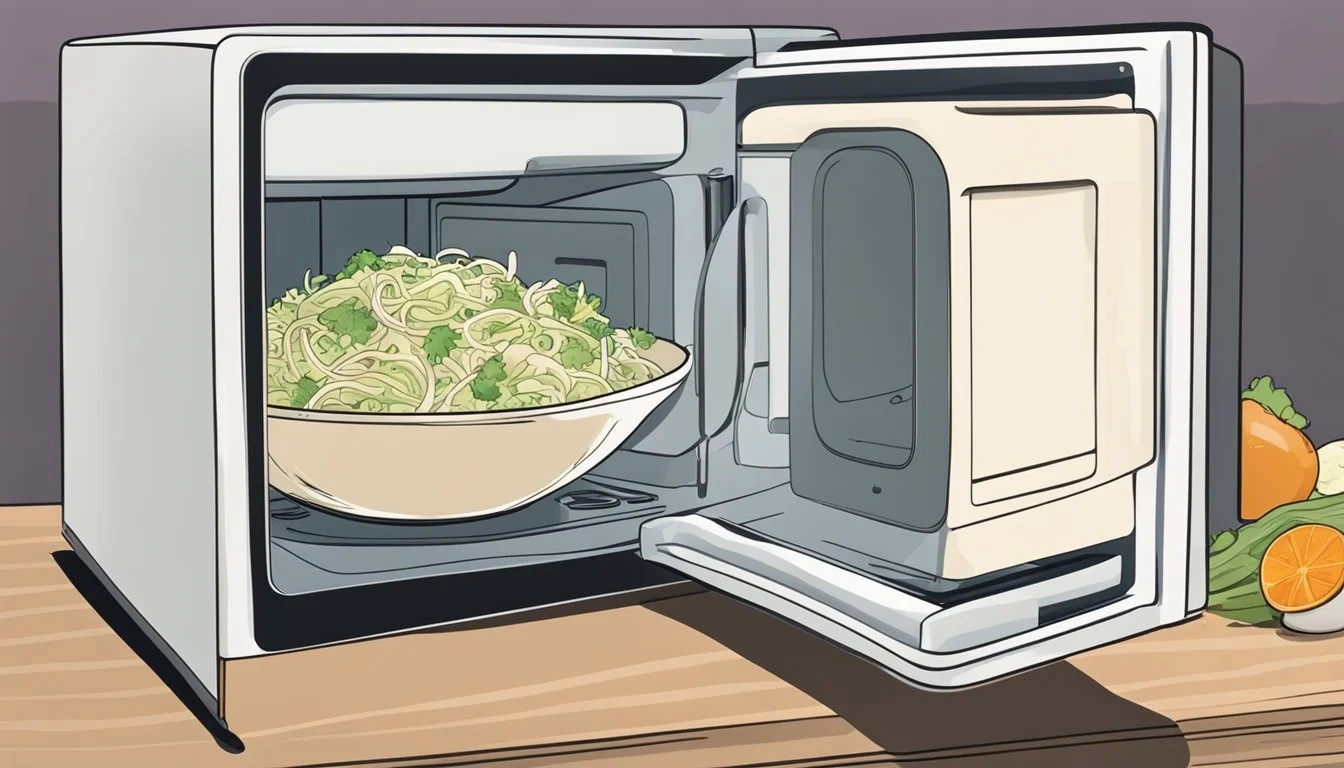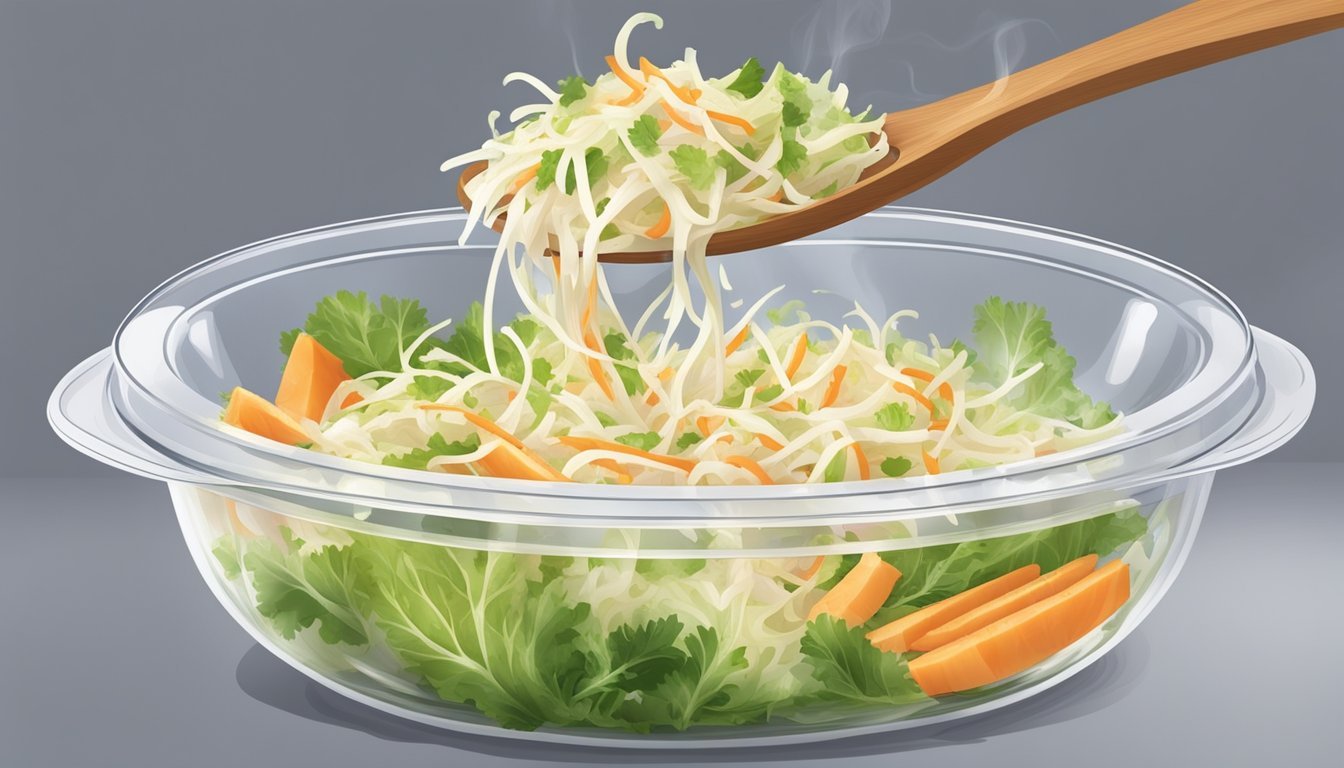How to Reheat Coleslaw
Essential Tips and Techniques
Reheating coleslaw might seem unconventional, but it’s a handy trick when you want to enjoy this crunchy side dish without losing its delightful texture and tangy flavor. Whether you have homemade coleslaw or a store-bought variety, the right technique can make all the difference.
The key to reheating coleslaw lies in gentle warming methods that preserve its freshness. Using a skillet over medium heat can ensure even warming without turning it mushy. Stir occasionally to maintain the crispness of the cabbage and carrots.
Alternatively, for faster results, the microwave can be used, albeit with caution. Heat in short intervals and stir between to prevent overheating. Whether it’s part of a meal or a quick snack, properly reheated coleslaw can enhance your dining experience.
Understanding Coleslaw
Coleslaw is a popular side dish featuring a blend of shredded vegetables and creamy or tangy dressing. Key factors like ingredients, texture, and dressing variations significantly impact the dish.
Key Ingredients
Coleslaw primarily relies on cabbage varieties such as green, red, or purple cabbage. Carrots are often added for their sweetness and color.
Ingredients such as sugar, vinegar (apple cider vinegar, for example), and salt play crucial roles in balancing flavors.
Additional elements can include dijon mustard, celery seed, and lemon juice to enhance the complexity.
Fresh herbs like parsley and dill also add an aromatic touch, while homemade coleslaw mixes and store-bought coleslaw mix offer convenience.
The Importance of Texture
Maintaining the right texture in coleslaw is essential. The ideal coleslaw should be crisp, not soggy.
Cabbage and carrots need to be shredded finely to achieve this texture. Salt can be used to draw out excess moisture from the cabbage before mixing it with other ingredients.
Avoiding advance mixing of the dressing and vegetables prevents them from becoming watery. For added crunch, try using a combination of green and red cabbage.
Coleslaw Dressing Variations
Coleslaw dressings come in numerous varieties, often based on mayonnaise, sour cream, or vinegar.
A creamy dressing typically includes mayo, sour cream, and sometimes sugar.
A vinegar-based dressing might feature apple cider vinegar, lemon juice, and a touch of dijon mustard for zest. Balanced proportions ensure the flavors meld well.
Experimenting with these ingredients enables various unique taste profiles, from tangy to sweet, to complement the base of cabbage and carrots effectively.
Proper Storage for Coleslaw
To keep coleslaw fresh and tasty, proper storage is essential. This involves correct refrigeration methods and understanding whether freezing coleslaw is a viable option.
Refrigeration Tips
Refrigerating coleslaw correctly helps maintain its crisp texture and flavor. Place the coleslaw in an airtight container to prevent it from absorbing other odors from the fridge and to reduce the risk of bacterial contamination.
Steps:
Transfer coleslaw to a suitable airtight container immediately after preparation or purchase.
Label the container with the date to track freshness.
Store it in the refrigerator at a temperature below 40°F (4°C).
Coleslaw usually remains fresh for up to 3-5 days if stored correctly. Pre-shredded cabbage can be kept separately to maintain its crunch longer.
Can You Freeze Coleslaw?
Freezing coleslaw is not always recommended, as it can become mushy when thawed. This change in texture happens because the water in the vegetables freezes and then breaks down the cell walls when thawing.
Considerations:
Creamy Dressings: Coleslaw with mayonnaise or cream-based dressings generally doesn't freeze well.
Vinegar-Based Dressings: Coleslaw with vinegar-based dressings can be frozen with better results.
Instructions:
Place coleslaw in an airtight container or heavy-duty freezer bag.
Remove as much air as possible to prevent freezer burn.
Label and date the container.
When ready to use, thaw coleslaw in the refrigerator overnight and stir well before serving.
Preparation Tips Before Reheating
Proper preparation ensures that reheated coleslaw retains its desired texture and flavor. This includes handling creamy dressings and ensuring even heating.
Handling Creamy Dressings
Creamy dressings can separate or thicken when reheated. To avoid this, start by stirring the coleslaw thoroughly to mix the ingredients evenly. Adjust the slaw dressing if necessary by adding a small amount of water or milk to reach the desired consistency.
Use a paper towel to blot excess liquid before reheating. This step helps in retaining the coleslaw’s texture without making it overly soggy. If the coleslaw recipe includes ingredients prone to wilting, such as fresh greens, consider removing them before reheating.
Ensuring Even Heating
Even heating is crucial for maintaining the quality of reheated coleslaw. For microwave heating, spread the coleslaw evenly in a shallow, microwave-safe container. Stirring halfway through the process prevents hot spots and ensures uniform warming.
For stovetop reheating, use a non-stick skillet over medium heat. Add the coleslaw and stir frequently. This method provides better control and reduces the risk of overheating any part of the dish. Pepper can be added during this step for extra flavor.
Maintaining the integrity of the coleslaw during reheating involves a combination of careful temperature management and consistent stirring. Following these tips helps ensure that the reheated coleslaw remains tasty and retains its original texture.
Reheating Techniques
To enjoy leftover coleslaw with its original flavor and crunchiness, it's essential to use the right reheating techniques. Here are three main methods to reheat coleslaw effectively: using a microwave, oven, or stovetop.
Microwave Method
The microwave method is the quickest and most convenient way to reheat coleslaw. Begin by placing the coleslaw in a microwave-safe dish. Cover the dish with a damp paper towel to retain moisture and prevent the coleslaw from drying out.
Heat the coleslaw in 30-second intervals, stirring between each interval. This ensures even heating and prevents overheating, which can make the coleslaw soggy. Typically, it takes about 1-2 minutes to reheat, depending on the quantity.
Be cautious with the microwave power settings. Use medium heat to preserve the freshness and flavor. Avoid heating for too long as it can lead to a loss of texture and make the coleslaw less appetizing.
Oven Method
Reheating coleslaw in the oven helps maintain its crispness. Preheat the oven to 350°F (175°C). Spread the coleslaw evenly on a baking sheet lined with parchment paper. Cover the coleslaw lightly with aluminum foil to keep it from drying out.
Place the baking sheet in the oven and heat for about 10-15 minutes. This method takes longer than microwaving but provides a more consistent and flavorful result. Check the coleslaw occasionally to avoid overheating.
For best results, stir the coleslaw halfway through the reheating process. This ensures even heat distribution and maintains the coleslaw’s crunchiness. Remove the coleslaw from the oven once it’s heated to the desired temperature and serve immediately.
Stovetop Method
The stovetop method involves reheating coleslaw in a skillet. Heat the skillet over medium heat before adding the coleslaw. This technique is beneficial for reheating small to medium quantities of coleslaw.
Add the coleslaw to the skillet and stir continuously. This prevents the coleslaw from sticking to the skillet and ensures even heating. Be sure to heat the coleslaw for only a few minutes, as prolonged heating can overcook it and affect the texture.
This method provides a quick and effective way to reheat coleslaw without sacrificing too much of its original quality. Serve the coleslaw warm, ensuring it retains its flavorful and fresh characteristics.
After Reheating
Once the coleslaw has been reheated, there are several ways to enhance its flavor and serve it effectively. These steps will help ensure that the reheated coleslaw remains both flavorful and crunchy.
Enhancing the Flavor
To boost the tangy and fresh taste of coleslaw after reheating, consider adding a splash of apple cider vinegar or a squeeze of fresh lemon juice. This will revive the flavors that may have dulled during the reheating process.
For an extra flavorful twist, sprinkle some fresh herbs such as parsley or dill on top. If you enjoy a bit of spice, a dash of hot sauce can add an exciting kick.
Additionally, mixing in a bit of extra sauce can help restore any creaminess lost during reheating. Choose a mayonnaise-based or vinaigrette sauce that complements the original recipe.
Serving Suggestions
Reheated coleslaw can be an excellent side dish for a variety of meals. Serve it alongside BBQ chicken, ribs, or pulled pork for a classic combination.
For added crunch, consider topping the coleslaw with some toasted nuts or seeds. This can give it an extra texture boost.
Coleslaw can also be a perfect side for sandwiches and burgers. Place it inside the sandwich or burger for a crunchy and tangy dimension.
In addition, try diverse variations by incorporating fruits like apple slices or raisins for a slightly different but delightful flavor profile.
Common Mistakes to Avoid
When reheating coleslaw, it's important to keep certain mistakes in mind to maintain its flavor and texture. These key points focus on avoiding sogginess and preventing overheating.
Avoiding Sogginess
To prevent coleslaw from becoming watery, start by ensuring it's properly salted and drained. Salt the shredded cabbage with about one tablespoon of kosher salt for every six ounces of cabbage. Allow it to sit in a colander for 10 to 15 minutes to draw out excess moisture.
Make sure to pat the cabbage dry with a paper towel before reheating. This step is crucial as it helps retain the crunch. If adding fresh ingredients, do so after reheating to maintain their texture and flavor.
Preventing Overheating
Reheating coleslaw gently is essential to avoid turning the cabbage mushy. Use low heat and stir frequently to ensure even warming. Overheating can cause the vegetables to lose their crispness, leading to an unappetizing dish.
Microwave the coleslaw in short intervals, checking and stirring in between, or warm it slowly on the stove over low heat. This approach helps maintain the coleslaw's tangy flavors and fresh texture.
Alternative Uses for Leftover Coleslaw
Leftover coleslaw can be transformed into a variety of new dishes and used in quick recipes that enhance its original flavors and textures.
Creating New Dishes
Leftover coleslaw can be a fantastic base for creating new dishes.
Rice Bowls: Add coleslaw to rice bowls along with other veggies to create a colorful and nutritious meal that can be customized with proteins like tofu or grilled chicken.
Wraps and Sandwiches: Use coleslaw as a filling in wraps or sandwiches. The creamy texture of coleslaw pairs well with ingredients such as pulled pork, grilled chicken, or even a vegan substitute like tofu, making a satisfying meal.
Salads: Mix leftover coleslaw with leafy greens like lettuce or spinach to create a new, vibrant salad. Add a tangy vinaigrette or sweeter dressings to balance the flavors.
Pizza Topping: Surprisingly, coleslaw can be used as a pizza topping. It adds a crunchy texture and unique flavor, especially on BBQ-flavored pizzas.
Quick Recipes
If you need quick and easy solutions for leftover coleslaw, these ideas may be a perfect fit.
Burgers: Enhance homemade burgers by adding coleslaw directly on top. The combination of a juicy burger and the crunchy, tangy slaw is a hit for cookouts and potlucks.
Egg Roll in a Bowl: For a simple yet flavorful dish, combine coleslaw mix with ground meat or a plant-based alternative, soy sauce, and a few spices. This quick meal is both satisfying and nutritious.
Potluck Dishes: Incorporate coleslaw into classic potluck dishes. Add it to a veggie platter, or mix it with granulated sugar for a sweeter side dish that pairs well with summer meals. Serve alongside KFC-style fried chicken or other BBQ favorites for a delightful combination.
Health and Dietary Considerations
When reheating coleslaw, it's important to consider nutritional content and dietary restrictions. Coleslaw, especially homemade, can be tailored to various dietary needs such as gluten-free and vegan.
Nutrition Information
Coleslaw can be a nutritious dish when made with the right ingredients. A standard recipe typically includes shredded cabbage, carrots, and a dressing. The nutrition profile includes:
Calories: Approximately 150-250 per serving, depending on the dressing.
Macronutrients: Typically high in vitamins A and C, fiber, and low in calories.
Fats and Sugars: Creamy dressings can increase fat and sugar content.
Opting for a Greek yogurt or vinegar-based dressing can reduce calories and fat, enhancing the nutritional value.
Gluten-Free and Vegan Options
For those with gluten sensitivities or following a vegan diet, coleslaw can easily be adapted. Ensure all ingredients, including dressings, are gluten-free. Here are some tips:
Vegan Dressing: Use Greek yogurt alternatives like coconut yogurt or silken tofu blended with vinegar, mustard, and maple syrup.
Gluten-Free Ingredients: Double-check that all components, including vinegar and mustard, are labeled gluten-free.
These adjustments allow everyone to enjoy a tasty, dietary-appropriate version of coleslaw.
Bonus Tips
Ensuring coleslaw stays fresh and jazzing it up with advanced seasoning techniques can significantly enhance its taste and texture. Proper reheating can transform leftovers into an enjoyable dish as good as freshly made coleslaw.
Maximizing Freshness
To keep coleslaw fresh, store it in an airtight container in the refrigerator. This prevents the cabbage from wilting and the dressing from separating. When reheating, avoid using the microwave, as it can make the coleslaw soggy. Instead, opt for an oven method.
Preheat the oven to 350°F. Spread the coleslaw on a baking sheet and cover it with aluminum foil. Bake for about 10-15 minutes, checking regularly to avoid overheating. For added crispness, remove the foil for the last few minutes.
If the coleslaw contains mayonnaise, be cautious, as it can turn oily when reheated. Mixing in a little vinegar before reheating can help maintain its tangy flavor.
Advanced Seasoning Techniques
Enhancing the flavor of reheated coleslaw can be achieved with additional seasoning. Consider incorporating white wine vinegar or apple cider vinegar for a more complex taste profile. A splash of vinegar before serving can revitalize the dish.
Adding chopped fresh herbs like parsley, dill, or cilantro can provide a burst of freshness. These herbs not only improve the flavor but also add a vibrant color contrast.
For a twist, consider adding finely diced apples. The sweetness and crunch of apples pair well with the tangy coleslaw base. Another idea is to sprinkle some toasted nuts, offering a delightful texture.
Trying out these seasoning modifications can elevate the simple coleslaw into a more dynamic and tasty dish.










